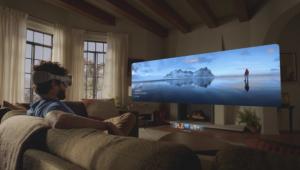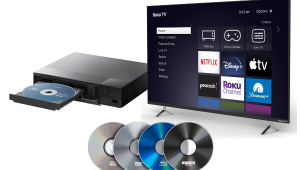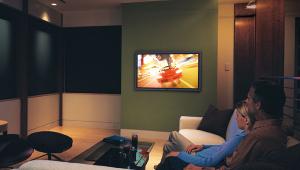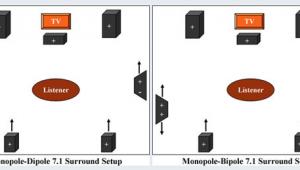I could care less really because I think what we have now is good enough.
Primary tabs
Which is More Important at Home, 3D or 4K?
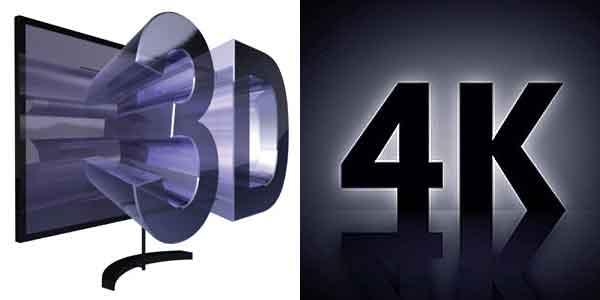
On the other hand, everyone I talk with is eager to see 4K home-theater displays, which have four times the resolution of "ordinary" high-def. Now that we've reviewed the first such display—the Sony VPL-VW1000ES projector—I wonder how important 4K really is, especially given that commercial 4K content for home use is not likely to be available for years to come, leaving owners of these displays with only upscaled 1080p and their own high-resolution still photos.
So I ask you—which do you think is more important for home theaters, 3D or 4K? Perhaps you believe both are equally significant or that neither one is important. In any event, your fellow home-theater geeks want to know what you think!
Vote to see the results and leave a comment about your choice.
- Log in or register to post comments


I voted 4K higher resolution is in my book always better.
But there is no 4K content nor will there be for a very long time, many films have only been captured at 2K and as I understand it CG effects are often done at 2K and would have to be unconverted to 4K
3-D is not for everyone but the films are here as well as the hardware. The general "uneducated" public watching awful looking streaming movies are unlikely to care about 4K as they see no value in 2K. if 4K is released it will no doubt be the foray of the uber geeks.

Well, obviously the answer in terms of "more important to the current marketplace" is 3D. There is 3D content, however bad it is, and there is a steadily growing install base of two types of 3D display (which, thankfully, play the same media).
4K has no media, no distribution channels, and one home electronics product that retails for $25k. I certainly can't say that it will never happen, but I am dubious as to the prospects of studios releasing 4K movie files to the public, for all sorts of reasons.
But I answered the question insofar as it applies to me and what I care about. That's why I chose "neither." I don't care about 3D because nothing has struck me as anything more than a gimmick, home quality is not up to snuff, and the entry cost is too high for a person who just got a 2D TV in 2010. I don't care about 4K because it's a paper tiger. If I thought that storage existed, distribution channels existed, and prices would be reasonable (say $30 per flick) I'd be much more interested. But then, entry cost again is an issue.
So I don't care about either one.

Don't you think extremely high quality BRD transfers viewed on the top Panasonic, Kuro or new Sharp Elite are good enough?

High quality BRD can look really good. But you can't call yourself a true home theater enthusiast if "good enough" is in your vocabulary. We ALWAYS look forward to the next improvement. Good Enough? Never!

Remember when 1080p was first being introduced. I remember the first 1080p TV I saw was a Mitsubishi DLP and the source.....a hard drive. There was NO content, and still today we have nearly zero broadcast content. Yet it is thriving. The upconverted cable and satellite images look stunning.
I personally have seen the 4k Sony Projector in our showroom with both 4k native, and upconverted content. And I can honestly say it's jaw dropping.
3D is not jaw dropping, it's neat at best.
BRING ON THE 4K!!!

I don't think my home is big enough to fit a screen large enough to be able to see the difference between 1080p and 4k.
How big would the screen need to be and what seating distance would I need to have to see the difference?
Presently I'm 8 feet (eyes to screen) from a 60" 1080p screen. Any farther away and I'd have to compromise the speaker placement too much, the left side speaker is already too close to the wall so I used acoustic treatment to compensate, putting the speaker all the way into the corner would be too awkward, unacceptable. In other words, my room is already a bit small for the 60". I'd have to remodel my house to support 4k.

I have found that passive 3D like those with the LG give me a better 3D experience than shutter glasses' 3D. More brightness, no ghosting, no flicker, etc. It really makes for a good 3D experience (when the movie is mastered correctly that is). The problem is the resolution issue where the vertical resolution is divided between the left and right eye and it looks like it has scan lines though you really don't loose any detail... But with 4k (or really "faux K" 3,840 x 2,160), having twice the vertical and horizontal resolution lines will make the lines from the FPR technique twice as small so they are less noticeable, and allow for closer seating distances. I don't believe it will provide for scaling issues since its just a doubling of the pixels, not really a re-scaling like going from 720p to 1080p
Just my opinion.
edited to better express my thoughts (Dec 19)

Even BR looks too sharp on my 60" plasma, and it's not until a much larger size that it looks less video. I expect that 4K has its place for extremely large screens, but none of these is going to fit in a home. IMO it's just another marketing ploy to get consumers to replace their catalogs yet again.

Having seen the Sony 4K with actual 4K content, and having seen almost every 3D demo out there, there is no way I'd pick 3D over 4K. If you are sitting 8' away from a 60" screen, then it's not going to matter as much to you. I sit 11' away from a 122" 2.40 screen, and I could certainly use the extra resolution. I have to get very close to the screen to see pixel structure, but the demos of the 4K Sony were jaw dropping with real 4K content.
There is also the fact that most projectors and displays can't display full 1080p resolution as soon as motion is introduced, as the technology can't refresh quickly enough to handle it. The extra resolution that is present in 4K projectors might allow all the resolution of 1080p to be resolved, even with the image in motion, which would lead to a better experience with existing content as well as future content.
3D is a nice gimmick for some people, but the standard 120Hz active refresh rates cause me a headache, and the resolution loss in passive sets is very annoying in films like Tron Legacy with lots of diagonal lines that lead to aliasing. Having seen both, it's an easy choice for me, but 4K matters more if you have a large enough screen of course.

I'd rather see 48 and 60 fps 2-D become standard. Hopefully the next projects from Peter Jackson (48 fps) and James Cameron (60 fps) will trigger a move to delivery of higher frame rates in home theater. Most of our displays can handle this now because of active 3-D. Hopefully the source components and media will as well.

the resolution is the 4th aspect of picture quality behind of the contrast, color saturation and color accuracy. 4k only matters if your display is 70 inches or more, and your seating distance is 10 FTs. I don't find logical 4k in displays of 60 inches or less... So many movies are filmed in 2k resolution (HD cameras) and up scaling always gona be problematic in diferents ways...

I think 4K is winning in this poll for one reason: because we don't have it yet. If 4K was available to the average consumer but 3D was still a dream on the horizon, I bet 3D would be "more important at home."
My vote was for both. Passive 3D at 4K resolution would be very yummy!

4K & 3D may be posed as opposing technologies by many vendors, but I think they'll both see a major use in Home Theater as the years tick by. 3D, for instance, is a technology a lot of people seem genuinely excited over, except for having to wear glasses to enjoy it. If you use a 4K panel, however, you can do something similar to the Nintendo 3DS, where the 3D effect occurs at the screen itself, with no glasses required - the benefit here would be that you could also maintain full 2K DCI/1080p resolution on the panel itself for 3D, and still use it for 4K material in the future should it become commercially available.
On the projection side, things become a bit more difficult, as the technologies are harder to combine - likely, we will see 4K Projection used to eliminate "screen door" artifacts that occur from 1080p projection on large screens/close viewing distances, though 3D without glasses on a projection setup seems nigh impossible at this point in time, barring a massive innovation in projection screens or optics.
For flat panels, 4K+3D is definitely the future. 4K material will likely stay rare outside enthusiast channels (Though I'd gladly pay $40 for a BDXL movie-disc with a 4K video Master), but the added resolution would be put to great use in pushing 3D TV/Entertainment into the home for everyone to enjoy.
